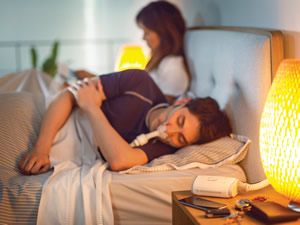Product Profile
'Honey, I Shrank the CPAP'
ResMed's new AirMini offers sleep therapy patients a go-anywhere solution. But packing a lot in a little required some creativity.
- By David Kopf
- Jun 01, 2017

Small enough to fit on top of a smart phone, the AirMini provides full-size capability.
One of the major frustrations for sleep therapy patients is traveling with their PAP therapy devices. A typical patient might have spent years undiagnosed, and now that he or she finally has a device that can ensure a good night’s rest, that patient is left figuring out how to take it on his or her summer vacation. And that’s a problem, because as any sleep therapy professional knows, therapy compliance can quickly erode if it’s not maintained.
“Travel is one of the biggest barriers to CPAP usage, and we know that 65 percent of patients cite size as the primary reason they leave their CPAP behind when they travel,” says Jon Yerbury, vice president of marketing in the Americas for sleep equipment maker ResMed Inc.
Which is why ResMed has released the AirMini, a PAP therapy device that takes the current trend of miniaturization for PAP devices to a whole new level. ResMed is billing the AirMini as the world’s smallest CPAP, and in terms of dimensions, the unit measures 5.4 in. by 3.3 in. by 2 in. Essentially, it can fit on top of a smartphone, which is certainly small enough for sleep patients to take anywhere.
“More people are traveling, creating a clear demand for a portable device,” Yerbury says. “According to the U.S. Bureau of Transportation, 63 million domestic travelers went through U.S. airports in May 2016. Based on research that one in four U.S. adults has sleep apnea, tens of millions of travelers a year could benefit from having an AirMini.”
Despite its small size, the AirMini functions like ResMed’s other PAP devices, packing the company’s AutoSet and AutoSet for Her functionality into a package that is practically pocket-sized, according to Yerbury. AutoSet is the backbone technology behind ResMed’s CPAPs. AutoSet devices constantly monitor patient breathing and automatically adjust pressure on a breath-by-breath basis (based on a three-breath average) to suit patient’s personal breathing needs throughout the night in order to deliver the minimum pressure required for effective therapy, which improves comfort and thusly increases compliance. The difference between ResMed’s other devices using AutoSet and the AirMini is that some people might mistake the AirMini for a small, bedside alarm clock.
AutoSet functionality is just one aspect of the AirMini more “maxi” capabilities. Other big-time features include:
- Portable, convenient waterless humidification to maximize comfort by capturing a patient’s exhaled heat and moisture with a HumidX humidifier in the mask tube, and redelivering it to them.
- An iOS and Android phone app for patients to change comfort settings and track their own nightly usage data, a practice that’s shown to increase compliance and health outcomes.
- Compatibility with ResMed’s AirFit N20 nasal and F20 full face masks (read “Finding the Right Fit”, January HME Business), which makes it easy for HME providers to fit on a wide range of patients (99 and 97 percent of patients, respectively, according to ResMed), as well as a special AirMini version of the AirFit P10 nasal pillows mask.
Of course packing all that functionality in a small package wasn’t exactly easy. One of the toughest parts was humidification. The AirMini needed a new approach. “… We needed to think beyond the traditional mask-and-device configurations we’re familiar with today, and this is how we arrived at ActiveAir technology,” Yerbury says. “In order to deliver greater breathing comfort to patients we need to offer them waterless humidification that actually works.”
Part of the challenge in making waterless humidification actually work, was that the device’s HumidX heat and moisture exchanger (HMX) absolutely had to be located between the patient and the vent. Otherwise, minimal moisture would be captured, Yerbury explains.
“In order to deliver an HMX in this location, we needed to relocate the mask vent farther down into the tubing,” he says. “Our engineers did a fantastic job delivering on these opportunities to ultimately design a pocket-sized device ideal for traveling.”
And ultimately, this means that CPAP patients might have a travel-sized device, but it gives patients therapy quality, comfort, control and data visibility that is comparable to any beside CPAP. And that should be a boon to any HME provider that specializes in sleep therapy devices, because a device on the scale of the AirMini means increased freedom for their patients.
“HMEs are looking for areas to grow their business,” Yerbury says. “AirMini represents an additional revenue opportunity for them, an additional high-demand product line that helps them meet customer needs.”
Billable under E0601 for qualifying patients, the AirMini began shipping on May 31. Interested providers should reach out to their ResMed sales representative.
AirMini
ResMed Inc.
(800) 424-0737
ResMed.com
This article originally appeared in the June 2017 issue of HME Business.
About the Author
David Kopf is the Publisher HME Business, DME Pharmacy and Mobility Management magazines. He was Executive Editor of HME Business and DME Pharmacy from 2008 to 2023. Follow him on LinkedIn at linkedin.com/in/dkopf/ and on Twitter at @postacutenews.